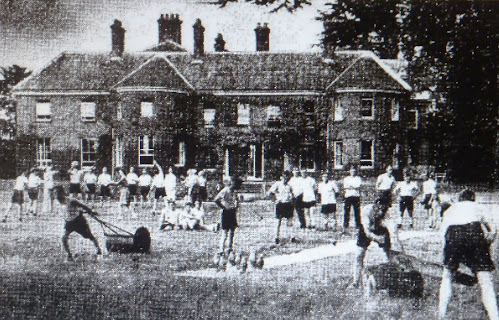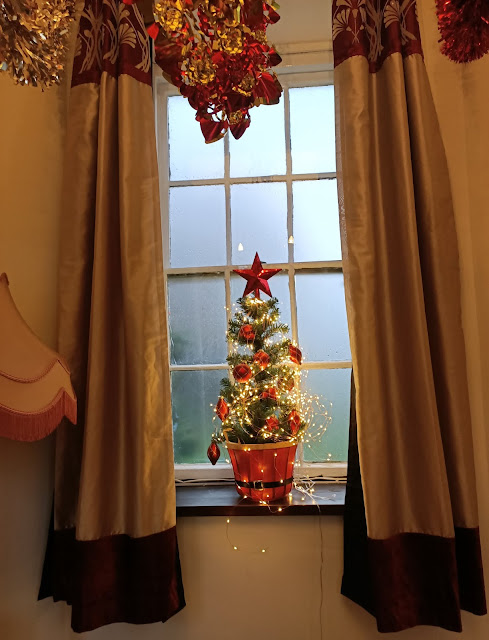Betley Court plays its part – A country house and the NHS
Last Sunday
(5th July 2020) marked the 72nd anniversary of the National
Health Service (NHS) in the UK. Nigel and I were on a family walk. We were in
the middle of nowhere (well, somewhere on the outskirts of a small town called
Audley) as the church bells chimed 5 o’clock, and people started the round of
applause in thanks for the NHS on its birthday. Even out in the countryside, we
could hear saucepans being clanged with wooden spoons, and a couple emerged
from their cottage by the footpath to join us in clapping for the NHS. It was a
timely reminder of how important the NHS is to the UK. The joining together of
people in a round of applause on Thursday evenings to thank NHS workers and key
workers has been a significant bonding moment for British people during the
Covid19 pandemic too. Betley Court as a Red Cross hospital in 1940
Many new
villagers to Betley will be surprised to learn that Betley Court has its own connection
with the NHS, as the house and grounds were once part of North Staffordshire
Royal Infirmary. During World War Two, Betley Court was rented to the government
and pressed into action as a Red Cross Hospital. This unit dealt with orthopaedic
cases (injuries to the skeleton) and rehabilitation of serving airmen. The
grounds provided ample outdoor space for recuperation and physiotherapy. 
Horticultural therapy taking place on the formal lawns, 1940
After the war, the unit continued, now dealing with injuries amongst men who worked in the North Staffordshire coalfields, using the expertise built up in the war to heal them. The miners’ treatment was paid for by insurance policies, personal savings and charitable donations. In 1948, it became Betley Court Rehabilitation Centre, under the management of North Staffordshire Royal Infirmary within the brand-new NHS. The centre continued to treat orthopaedic cases, expanding its remit to include the growing number of road traffic accidents. Being part of the NHS, it meant that treatment ‘should be comprehensive, universal and free at the point of delivery.’ What a difference that must have made to hard pressed families having to choose whether or not they sought treatment for health issues and injuries.
 |
| Betley Court Rehabilitation Centre as it closed in 1965 |
Surprisingly, this relatively recent period of Betley Court’s history was not that well recorded, and was in danger of being forgotten. I suspect that partly the recording of social history of ‘ordinary’ people is a discipline that has only really gained traction in the past couple of decades. What we do know about Betley Court’s history as part of the NHS has come from oral histories. Betley Local History Society has provided us with a fascinating ‘villagers view’ of the Rehabilitation Centre. Many women from the village were employed as cooks and orderlies. I’ve also had the pleasure of corresponding with three gentlemen who responded to an article I collaborated with for the ‘The Way We Were’ section of The Sentinel, our local newspaper. One of them, named Boyce Jones worked as the remedial gymnast – a profession that evolved to become the physiotherapy we’re familiar with today. He worked in the gymnasium, housed in the stable block (now a private residence called The Clock House) which had been converted in WW2. He provided me with a fascinating glimpse of the working day at Betley Court Rehabilitation Centre,
“I worked in the gymnasium with Mr Ballenger[the head remedial gymnast]. It was a long oblong room with all sorts of muscle resistance and mobility apparatus. The patients' day started after breakfast with all patients in the gym and the class exercised for half an hour. They were then divided into various groups according to their injury. Each patient of each group had a special routine to follow. It was our job to change the routine when we felt the patient was ready to move on. In the afternoon there were various physical games e.g. archery, cricket, ballgames to suit their disability and purposeful walks to the Dingle and back. There was no swimming in the Dingle as it was only a stream then. The walled garden was used by somebody to produce vegetables to feed the patients. The ground by the side of the house was mown and used for cricket.” Boyce Jones, 2015
Patients stayed in the main house during the week,
going home for the weekends. Another correspondent, Douglas Hulme, remembered
his father’s stay at Betley Court, following a catastrophic accident when his
dad’s leg became entangled in a coalmine conveyor belt. The leg was saved, but the
accident ended his work as a miner, and he endured months of rehabilitation.
Never-the-less, Douglas recalled his father’s praise for the treatment he received
at Betley Court. The consultant
who held a clinic at the centre each week encouraged games of cricket on the
front lawn. Those with hand injuries played near the wicket. Those with leg
injuries were encouraged to field. Patients were also ‘prescribed’ errands
around the village, to pick up papers or buy sweets and cigarettes to help their
rehabilitation.
A group of patients standing outside the gym (now the Clock House), 1960. Photo: from the Nixon family archive.
 |
| Two patients take a break from exercise, outside the gym, 1958. Photo: Hulme family collection. |
We’ve also heard from a former patient, who, as a young man of twenty, was referred to the centre as part of his recovery from a motor cycle accident. John Moores described life as a patient in Betley Court, saying,
‘All food, which was excellent quality, was provided. All food was cooked on the premises by local ladies who knew what they were doing. The ground floor dining room was a dedicated room with a bay window overlooking the well-manicured lawns at the rear/corner of the property.
Our upstairs bedroom was communal…Downstairs there was a large room with a full-size snooker table. There was a purpose-built well-equipped gym provided, all the patients attended and were put through quite a strict regime on a daily basis… In our leisure time I used to play snooker, darts and play chess with the instructor. I beat him at chess and the other patients were concerned that the instructor would give them a hard time because he lost. He didn’t, he was fair and a professional.’

Betley Court’s role in the NHS came to an end in 1965, and although the Fletcher-Twemlows, the Squire and his wife still owned the Court, they chose to live elsewhere, leaving the house empty and quietly decaying for thirteen years, until the Brown family bought it. This is a period of the house’s history that is inexorably sliding from living memory. Capturing these memories takes on a greater significance as the years pass, and the joy of the whole Heritage Lottery Fund project is that we’ve been given a chance to do it.
**UPDATE ON
TOMMY**
Our 'Tommy'
I had a
couple of lovely messages about ‘Tommy’ our sculpture of a World War One soldier
that we thought was lost in the fire. Tommy is now at Charis Jones’ blacksmithing
forge in Etruria. Charis has quite an array of hammers, and more importantly,
the skills to flatten out the sculpture. Where the metal has snapped, she’s
hoping to pop a couple of rivets in with a supportive piece of metal. I’m
looking forward to the day, hopefully not too far in the future, when we can reclaim
the Peace Garden from the contractors, reinstate the Peace Sculpture, and Tommy
can take pride of place. He has quite a story to tell!
The break that happened as Tommy was extracted from the ashes. Charis hopes to mend with rivets and a piece of supporting metal.



Comments
Post a Comment